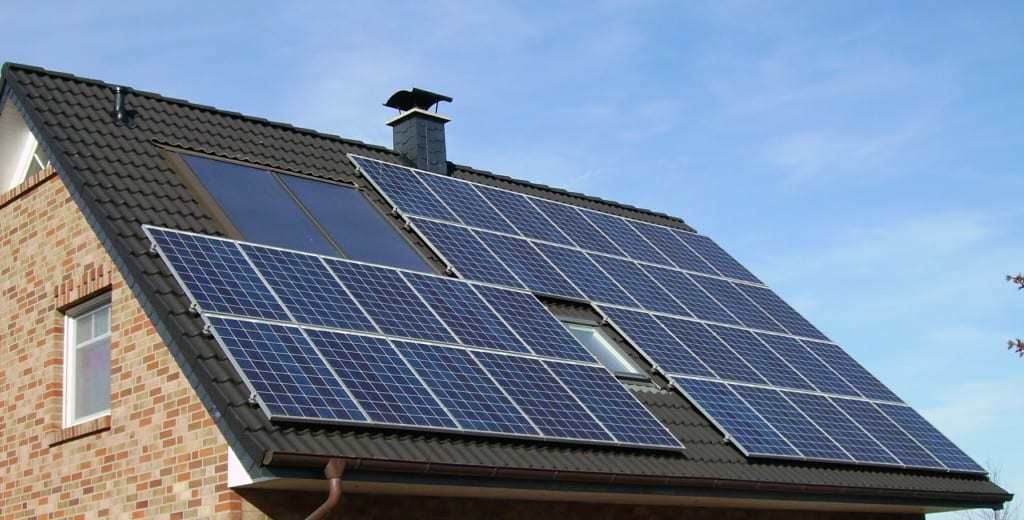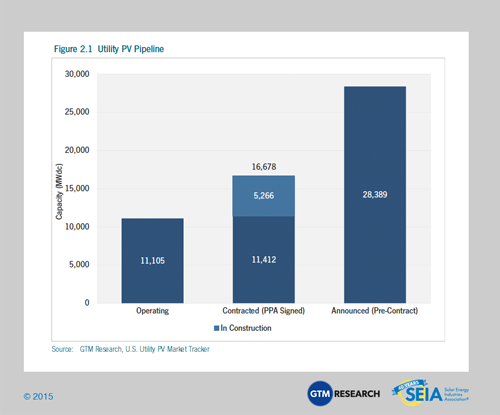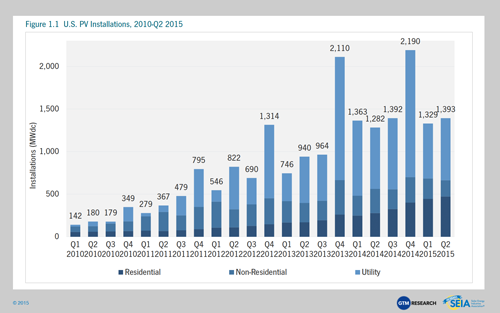By Glynn Wilson –
WASHINGTON, D.C. – In spite of the naysayers on the political right, solar power continues to grow as a significant source of energy in the economy of the United States, setting records every year, according to a new report out from the Solar Energy Industries Association.
Out of all new electricity installations in the country during the first six months of 2015, 40 percent were solar, according to the report.
“It’s setting records every quarter,” Shayle Kann, senior vice president of GTM Research and lead author of the report, said in the announcement. “There’s no way it’s not a record year. The question is how much we break the record by.”
Solar photovoltaic installations now exceed 20 gigawatts in capacity and could surpass an unprecedented 7 gigawatts this year alone. A gigawatt is equivalent to 1 billion watts and can power about 164,000 homes.
“The demand for solar energy is now higher than ever and this report spells out how crucial it is for America to maintain smart, effective, forward-looking public policies, like the ITC, beyond 2016,” said Rhone Resch, SEIA President and CEO. “At over 20 GW of installed solar electric capacity, we now have enough solar in the U.S. to power 4.6 million homes, reducing harmful carbon emissions by more than 25 million metric tons a year. Since the ITC was passed in 2006, U.S. solar growth has exploded and more than 150,000 American solar jobs have been created. By any measurement, that’s a success for both our economy and environment.”
The report documents a new record for residential rooftop solar installations, which grew by 70 percent over the previous year, generating 473 megawatts of residential solar capacity.
The report comes just weeks after President Barack Obama traveled to Las Vegas, where solar is growing rapidly as a percentage of the market, to boost solar as an icon of progress and technological innovation.
“This is an age-old debate in America,” the president said. “It’s a debate between the folks who say ‘no, we can’t,’ and the folks who say, ‘yes, we can.’”
In 2014, 6.2 gigawatts of solar photovoltaic installations were documented. The report projects a total of 7.7 gigawatts by the end of 2015 as a large number of utility scale solar projects come online, the single largest part of the market.
Yet some of the Republican candidates for president seem to feel they gain political points by bashing the future of solar power.
Louisiana Governor Bobby Jindal, who signed legislation to end solar tax credits, has said: “Republicans seem instinctively to oppose cultivating … solar and wind power. Likewise, Democrats often stridently oppose … oil, coal, and nuclear power.”
Senator Rand Paul makes no bones about his beliefs that government should not be playing favorites in the market, so it is no surprise that he is not a fan of government-funded solar programs. In fact, he blames “government intervention” for much of the nation’s energy problems.
“I favor tax incentives for alternative energy, but I oppose subsidies, which has the effect of allowing the government to choose winners and losers,” he has said. That would mean opposing subsidies for fossil fuel industries, which he has not done, which give them an unfair advantage over emerging renewable technologies.
According to the LA Times, the Koch brothers have a new ploy to protect the traditional energy business that helped make them the planet’s fifth- and sixth-richest humans. They are funding a campaign to shackle solar energy consumers who have escaped the grip of big electric utilities.
As a result, their favorite candidate in the race, Governor Scott Walker of Wisconsin, wants to eliminate funding for a University of Wisconsin-Madison renewable energy research center that has played a key role in helping land one of its biggest government grants ever. According to the Wisconsin Journal, in his budget, Walker proposed eliminating $8.1 million over two years — a total of 35 positions — from a bioenergy program.
Yet the data shows that even in the market segment where performance wasn’t as strong last quarter, the non-residential market, activity is picking up. Shared or “community” solar projects, where residents of a neighborhood, condo or apartment building invest collectively in a larger solar installation, is also expected to see rapid growth.
“Shared solar or community solar is a market that’s just emerging, and we think has real legs,” Kann says.
U.S. solar photovoltaic is at 20 gigawatts of installed capacity and is projected to add another 18 gigawatts by the end of 2016.
The growth boom is being fueled by a combination of declining costs, low interest rates and a federal solar investment tax credit.
Additional key findings of the report show that the second quarter of 2015 was the 7th consecutive quarter in which the U.S. added more than a gigaWatt of solar power, with cumulative installations eclipsing 20 gigaWatts. Throughout the first half of 2015, 40 percent of all new electric generating capacity brought on-line in the U.S. came from solar. It also shows that 21 states have now added more than 100 MegaWatts of solar, but the top five states still account for nearly 75 percent of cumulative installations.
Also, 40 percent of the 16.6 gigawatt utility pipeline in development has been procured primarily due to solar’s economic competitiveness with fossil-fuel alternatives.
The report forecasts that installations will reach 7.7 gigawatts in 2015, up 24 percent over 2014, and concludes: “Growth will occur in all segments, but will be most rapid in the residential market.”
















